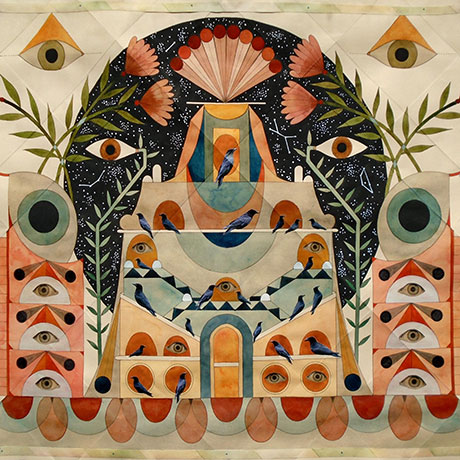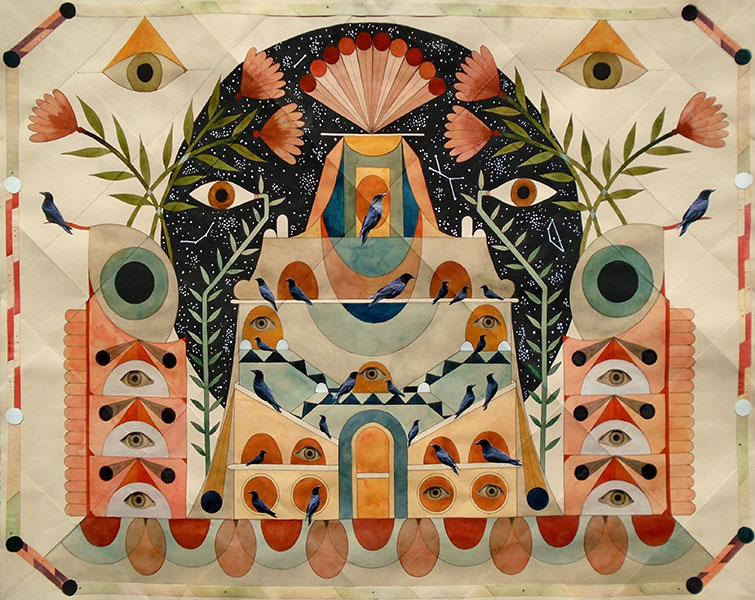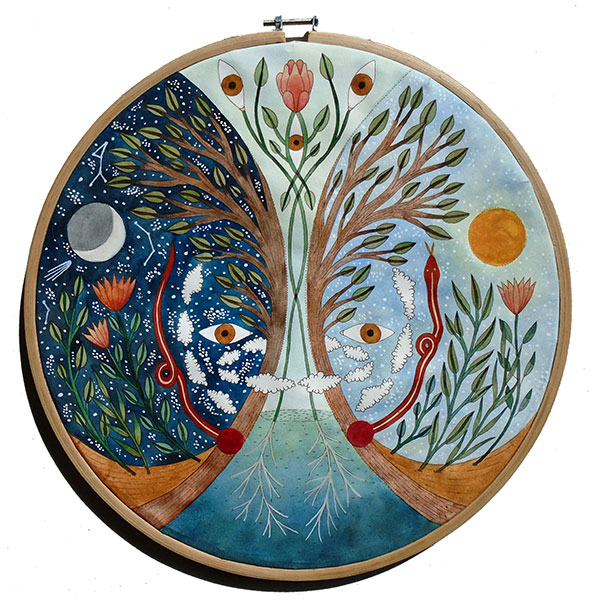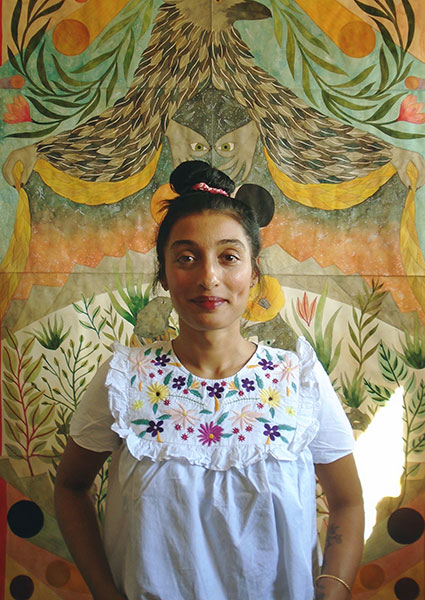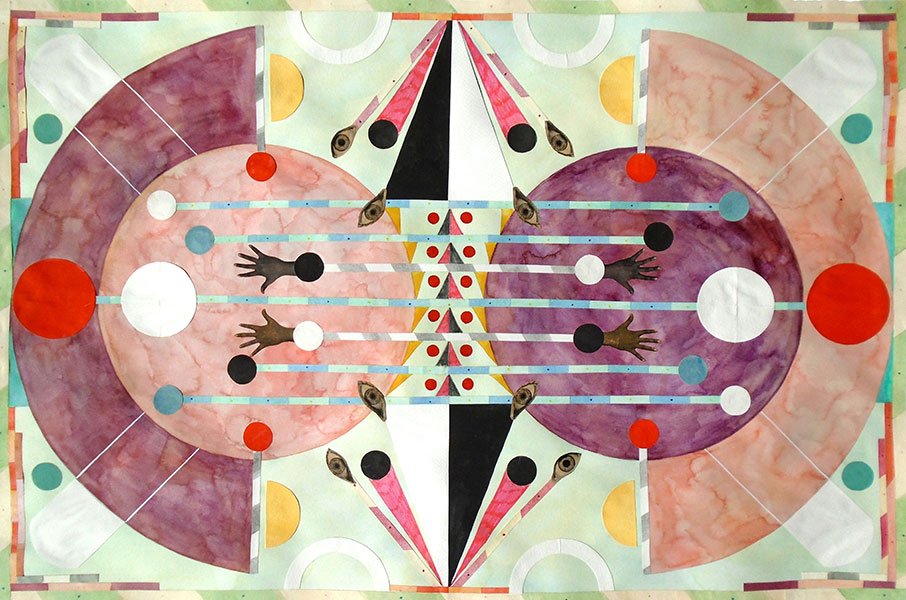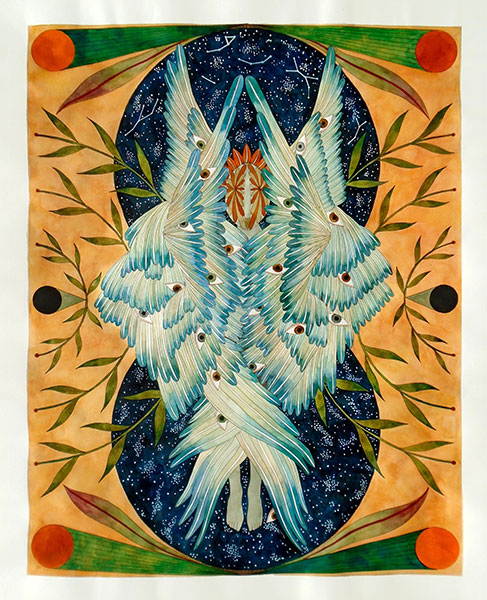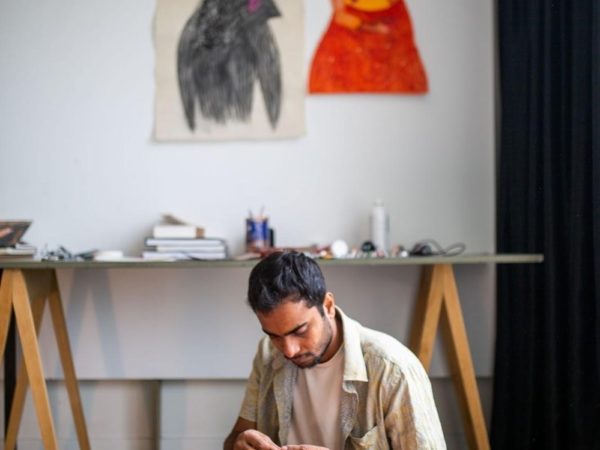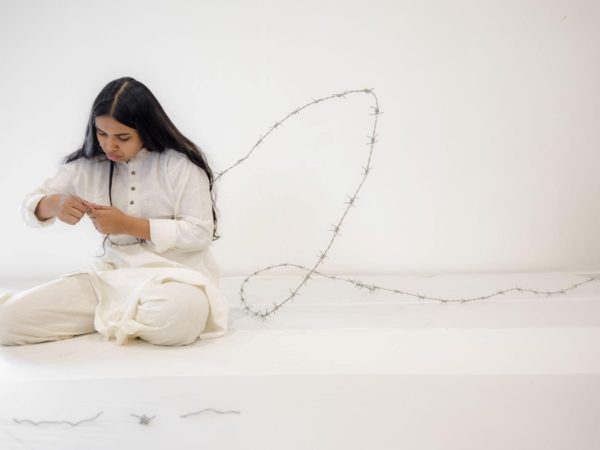Rithika Merchant, born and raised in Bombay (Mumbai) graduated with a Bachelors in Fine Arts from Parsons the New School for Design in New York in 2008. She also pursued studies in painting and conceptual practice at the Hellenic International Studies In The Arts in Paros, Greece.
Rithika’s work explores the common thread that runs through different cultures and religions. Similar myths, stories and ideas are shared by cultures all around the world, her paintings explore this concept while also featuring creatures and symbolism that are part of her personal visual vocabulary. Nature plays a pivotal role in the artist’s work and is emphasised by the use of organic shapes and non saturated colours. Her paintings and collages are made using a combination of watercolour and cut paper elements, drawing on 17th century botanical prints and folk art, to create a body of work that is visually linked to our collective pasts.
SP: Your works are predominantly inspired by mythology from around the world. I would like to know what fascinates you so much about mythology?
RM: My interest in myths began when I read Joseph Campbell’s Hero With a Thousand Faces. The book really opened my eyes to the universality of the human experience and how it informed many myths.
I have always been very interested in narratives, myths and received histories that are available to us. I am also interested in how these different fragments are “woven” together to from a complete image. Most cultures use imagery to tell stories and represent ideas. I try to use these ancient means of storytelling in a more contemporary context.
In the past art and stories were often a way to make sense of natural phenomena and psychological events. In modern times and for the foreseeable future, science gives us a complete explanation for most things. However, it places humans as part of a greater scheme rather than the centre of our own narrative. As much as science gives a more accurate description of humanity it takes away the spiritual power given to every human to understand their own destiny. Myth making brings humanity back to the centre of concern.
SP: Any special moments of creation that you would want to share with us?
RM: In the last few years I have been experimenting with collage. My collages began from a need to express certain ideas in a graphic non narrative way. These works come from a much more personal and intuitive way of seeing. Less about research and more about taking a feeling or concept and representing it visually. I find collaging very meditative and peaceful – it’s also a great mental break from my more researched figurative works.
SP: Where do you position yourself as an artist in the contemporary times?
RM: Art has the power to inspire, excite, engage and give us strength. I feel especially grateful to be an artist and to have the means to navigate our world and find meaning during these especially difficult times.
SP: Your Compositions are very pleasing to the eyes and aesthetically dominant. I am interested to know your take on the conceptual inquiry of your practice.
RM: I’ve always seen stories and ideas visually and have always felt compelled to bring these visions to life. For me, manifesting these ideas comes naturally. I have my own lexicon of symbols and creatures that I use in my work and so I use these as tools to help me as I visualise these ideas.
I spend a lot of my time reading and researching ideas I have, or subjects that I am interested in. I will often read something and have a very vivid image in my mind. Sometimes it’s just a flash.
Once I have a clear idea or image in my head I usually just start to draw directly onto my paper – I rarely sketch beforehand – then I add ink and paint. Sometimes I may do a colour wash or tint on the paper before I begin. If I am working on a folded piece, I will fold the paper or make some cuts before I start drawing. I also have a notebook in which I make lots of written notes and diagrams but I almost never make sketches or studies of things. I sketch more with words than images.
SP: What is the significance of the material in your art practice and how important is it?
RM: I primarily work with gouache, watercolour and ink on paper. I love watercolour because when you work with it you kind of have to mean it. You can’t paint over it or take it away. There is a finality with working with this medium that I really like. I also like that it’s less saturated, more faded and sort of translucent.
I like to refer to the folds on my paintings as the architecture of the artwork, or the scaffolding that I build each piece on. I usually fold the paper before I begin drawing and it serves as a guide for the parts of the piece I want to draw attention to, or sections I want to colour block. I usually make the folds to go along with the composition of the art work. I also like the textured, almost quilted effect it gives the piece.
After I finish the painting I fold it back up along the same creases to store it. Often, I am able to fold it into some sort of smaller geometric shape, and the paintings then turns into an object. In this way, the paper itself is part of the narrative.
SP: Since recently, you have been collaborating with the Fashion Industry. As a visual artist, venturing into the Fashion industry must have been quite an experience. Would you like to share your experience with us on this journey?!
RM: This collaboration came out totally by chance. Natacha was browsing the internet and pulling images and she came across my work. She really liked my work and said that it fit what she had in mind for the “painted dresses” . They then just googled my name and saw that I was living and working in Barcelona and so they sent me an email asking if I wanted to collaborate with them. It was totally out of the blue for me and a very nice surprise! Within a week or two we had chatted on Skype, I had been briefed on the scope of the project and that was it. They invited me to come to the studio in Paris to work with them on the dresses, and so I spent about 2 weeks there working with Natacha and the rest of the team to place my drawings on the garments.
I really enjoyed working with the entire team at Chloe. I’m so used to working alone all day in my studio, so it was a nice change to be part of the team and work on a creative idea together. It was also very interesting to learn about the process and to see everything that goes into the making of a collection. It’s amazing to see how much thought and work goes into each piece.
The paintings I worked on for this collection are filled with lots of esoteric and spiritual symbols and botanical imagery. Hands, eyes, roots, leaves. Lots of organic shapes which flow together. It was interesting and exciting to take my 2 dimensional drawings and transform them into a 3 dimensional format. Seeing the artwork evolve, become sculptural and have movement.
SP: Tell us something about your ongoing projects.
RM: I had read an essay about aerial women on the Oxford University Press academic blog and was very inspired by some of the theories put forth in it. I touched on some of these ideas in 2019, and recently I’ve been revisiting some of that research as I felt there are more ideas and thoughts linked to representations of winged women that I want to explore
SP: Your journey as an artist is fascinating and inspiring. It would be enlightening for the young generation to know your envisions of the future of your practice.
RM: I hope to always be evolving, exploring new ideas and telling stories visually.
SP: Any suggestions you would like to give to the young emerging artists and art practitioners?
RM: People tend to romanticise what artists do – but being an artist is a profession just like any other that requires a lot of hard work, patience and a thick skin. It’s a massive risk as well and there are constant ups and downs. You have to be very committed to it. The best piece of advice I have gotten is to just show up and work on my art every single day even if I don’t feel like it – to constantly hone my craft, to be committed and to make things happen for myself.
Also, have some sort of online presence – a website which documents and organises all your work, along with a little bit of information about you and your practice. There are lots of free website builders and templates available, and I think it’s important to have some sort of point of reference for people to discover and learn about what you do.
Some sort of social media is also helpful, just so people can keep up with your work in a more casual way. Even if you don’t post often, you never know who might stumble across your works.
Image Courtesy: Rithika Merchant, Diana Di Nuzzo
Find more about the Artist and the Artworks:
http://www.rithikamerchant.com/
https://www.instagram.com/rithikamerchant/?hl=en

